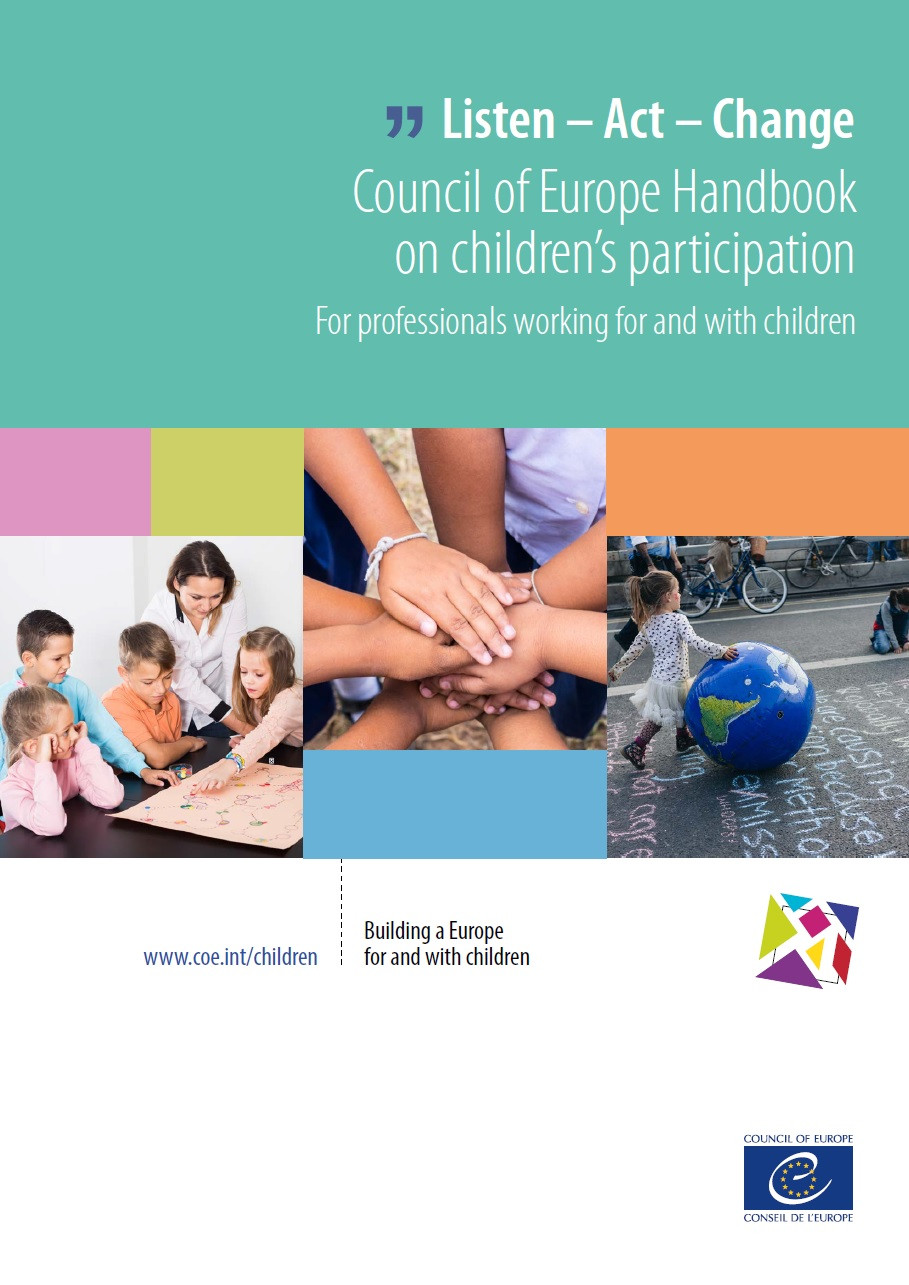PREFACE ACKNOWLEDGMENTS HOW TO USE THE HANDBOOK SECTION 1: UNDERSTANDING CHILDREN’S PARTICIPATION IN THEORY AND PRACTICE 1.1 CHILDREN’S RIGHTS TO PARTICIPATION IN MATTERS THAT AFFECT THEM
Figure 1: Dimensions of children’s participation
1.2 WHY IS CHILDREN’S PARTICIPATION SO IMPORTANT?
1.3 THE PROCESS OF CHILDREN’S PARTICIPATION – WHAT’S INVOLVED?
Figure 2: Participation as a rolling process that produces change
1.4 INFLUENCE IN PARTICIPATION PROCESSES
Figure 3: A first Lattice of Children’s Participation
Figure 4: A second phase Lattice of Children’s Participation
1.5 DOING IT WELL – SAFE, ETHICAL, INCLUSIVE AND IMPACTFUL PARTICIPATION
Practice note: Consent and child protection
1.6 ENABLING ENVIRONMENTS
Example: Increasing awareness of rights for children on the move
Example: Government youth portal for children
Hints and tips: Getting started
SECTION 2: DEVELOPING PARTICIPATORY ORGANISATIONS AND ENVIRONMENTS
2.1 ENSURING OWNERSHIP AT THE HIGHEST LEVEL
Example: Conversations and dialogue with government ministers
2.2 UNDERTAKING AN ASSESSMENT OF THE CURRENT STATE OF PLAY
Example: Child particpation assessment tool (CPAT)
2.3 DEVELOPING AN ORGANISATIONAL POLICY AND PROCEDURES
Example: Eurochild children’s participation strategy
Spaces and processes
Figure 9: Formal and informal participation spaces and activities
Example: Child-friendly Health Care
2.4 BUILDING STAFF CAPACITY
Training: Champions of children’s participation
Involving children in the recruitment and selection of staff
Example: Child participation in the recruitment of an ombudsman
2.5 SAFE AND CHILD FRIENDLY COMPLAINTS MECHANISMS
2.6 MONITORING AND REVIEWING IMPLEMENTATION
Checklist: A listening ‘alternative care’ institution
Checklist: A child-friendly and participatory classroom
Hints and tips: Making child particpation work in the long term
SECTION 3: SUPPORTING PARTICIPATION OF INDIVIDUAL CHILDREN
Example: The right to be heard
3.1 PREPARATION AND PLANNING
Example: Child-rights friendly environment
3.2 CONNECTING WITH CHILDREN
3.3 IDENTIFYING ISSUES AND PRIORITIES
3.4 INVESTIGATING CHILDREN’S VIEWS
Example: “BARNAHUS” (Children’s House) special safe settings
Example: Accessing independent support to express views
Practice note: Respect for evolving capacities
Example: Presuming capacity
3.5 TAKING ACTION
Practice note: Best interests of the child
3.6 FOLLOWING UP ACTIONS
3.7 REVIEWING, REFLECTING AND STARTING AGAIN
Checklist: Reflecting on discrimination
Hints and tips: Connecting with children
SECTION 4: COLLECTIVE PARTICIPATION
4.1 PREPARATION AND PLANNING
4.2 CONNECTING WITH CHILDREN
Example: Intergenerational support for activism
Example: Youth advisory group in child-friendly cities conference
Example: Collaborative priority setting
Example: 2getherLAND Camp Advisory Group
Example: Lithuanian School Students’ Union
4.3 IDENTIFYING ISSUES AND PRIORITIES
Example: Child-led priority setting
Example: Roma Children Map Community strengths and needs
4.4 INVESTIGATING CHILDREN’S VIEWS
Example: Online surveys for children
Example: Using photovoice as a method to listen
Example: Consulting young children on the quality of services
Practice note: Ground rules or group contracts
4.5 TAKING ACTION
Example: Identifying people who can be asked to act
Example: Self-advocacy – banning the use of garbage bags
4.6 FOLLOWING UP ACTION
Example: Follow-up actions after consulting with children
Example: Follow-up actions after children make demands
4.7 REVIEWING, REFLECTING AND STARTING AGAIN
Hints and tips: Practioner’s piorities for collective particpation
SECTION 5: RESOURCES
5.1 LEGAL STANDARDS
5.2 GUIDANCE ON AND EXAMPLES FOR CHILDREN’S PARTICIPATION IN DIFFERENT SETTINGS OR WITH DIFFERENT GROUPS
5.3 ACTIVITIES (COLLECTIVE PARTICIPATION)
5.4 ADVOCACY AND CHILD ACTIVISM
5.5 FURTHER TRAINING
5.6 PARTICIPATORY INSTITUTIONS
5.7 MONITORING AND EVALUATION
5.8 UNDERPINNING THEORY
5.9 OTHER
ANNEX 1: THE NINE BASIC REQUIREMENTS FOR EFFECTIVE AND ETHICAL PARTICIPATION:
THE IMPLICATIONS FOR PRACTICE
1. REQUIREMENT ONE: PARTICIPATION IS TRANSPARENT AND INFORMATIVE
2. REQUIREMENT TWO: PARTICIPATION IS VOLUNTARY
3. REQUIREMENT THREE: PARTICIPATION IS RESPECTFUL
4. REQUIREMENT FOUR: PARTICIPATION IS RELEVANT
5. REQUIREMENT FIVE: PARTICIPATION IS CHILD-FRIENDLY
6. REQUIREMENT SIX: PARTICIPATION IS INCLUSIVE
7. REQUIREMENT SEVEN: PARTICIPATION IS SUPPORTED BY TRAINING FOR ADULTS
8. REQUIREMENT EIGHT: SAFE AND SENSITIVE TO RISK
9. REQUIREMENT NINE: PARTICIPATION IS ACCOUNTABLE
ANNEX 2: PRODUCING ACCESSIBLE INFORMATION: GUIDANCE ANNEX 3: ENSURING SAFETY AND WELL-BEING: A CHECKLIST
AS YOU PREPARE YOUR ORGANISATION
BEFORE YOU START AN ACTIVITY
AT THE START AND DURING THE ACTIVITY
AT THE END OF THE ACTIVITY
ANNEX 4: CHALLENGING DISCRIMINATION: IMPLICATIONS FOR PRACTICE ANNEX 5: EXPLAINING CHILDREN’S ROLE IN MEETINGS AND PROCEEDINGS: A CHECKLIST ANNEX 6 COMMUNICATING WITH CHILDREN: A CHECKLIST
DO YOU ENSURE THAT?
CONNECTING WITH CHILDREN IS ENABLED WHEN:
ANNEX 7: PREPARING FOR COLLECTIVE PARTICIPATION: KEY QUESTIONS CONSIDER
WHAT ARE YOUR AIMS AND OBJECTIVES?
WHO COULD BE INVOLVED?
HOW CAN YOU ENSURE CHILDREN’S VIEWS RESULT IN ACTION:
WHAT RESOURCES CAN YOU SECURE?
ANNEX 8: SUPPORTING FREEDOM OF EXPRESSION AND ASSOCIATION: A CHECKLIST




